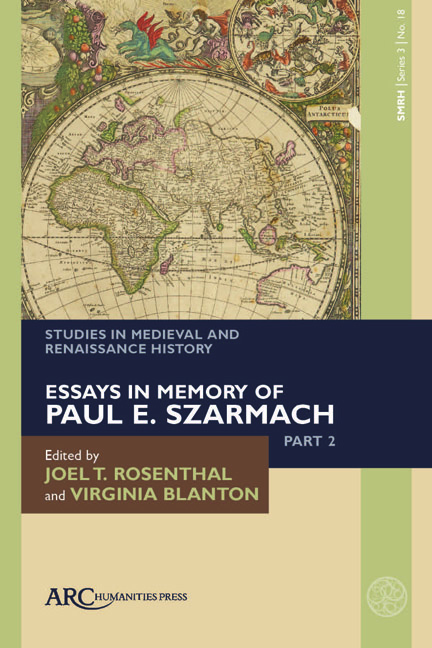Book contents
- Frontmatter
- Contents
- List of Illustrations
- Introduction
- The Development of Constantinian Themes and Their Manifestation in Writings and Coinages of Early England
- Echo and Icon : Life in Stone at Bewcastle, Cumbria
- Jerome of Strido at Chelles: The Legacy of Quedlinburg Codex 74
- Revisiting the Maaseik Zoomorphic Embroideries
- The Old English Version of Alexander’s Letter to Aristoteles and its Use of Binomials
- Agency and Obedience : The Afterlife of St. Swithun in Anglo-Saxon England
- B. and the Vita Harlindis et Renulae
- Wheelock’s Bede and Its Supplementary Materials : Goals and Methods
B. and the Vita Harlindis et Renulae
Published online by Cambridge University Press: 13 April 2024
- Frontmatter
- Contents
- List of Illustrations
- Introduction
- The Development of Constantinian Themes and Their Manifestation in Writings and Coinages of Early England
- Echo and Icon : Life in Stone at Bewcastle, Cumbria
- Jerome of Strido at Chelles: The Legacy of Quedlinburg Codex 74
- Revisiting the Maaseik Zoomorphic Embroideries
- The Old English Version of Alexander’s Letter to Aristoteles and its Use of Binomials
- Agency and Obedience : The Afterlife of St. Swithun in Anglo-Saxon England
- B. and the Vita Harlindis et Renulae
- Wheelock’s Bede and Its Supplementary Materials : Goals and Methods
Summary
THE SUNY PRESS volume Holy Men and Holy Women (edited by Paul Szarmach in 1996) was crucial for showing the way with its dual focus on the materiality of hagiographical texts and their intertextuality, and so it was a great privilege fifteen or so years later to contribute to the 2013 collection of essays that came out of one Paul's wonderful NEH Summer Seminars: Writing Women Saints in Anglo-Saxon England. Holy Men and Holy Women was important also for the equal footing on which it placed biographies of men and women: here, I want to honour those values in Paul's work, as well as his own generous support from an early stage in my career, by advancing a conjecture that would expand the oeuvre of a hagiographer from England, potentially giving us his earliest foray into the genre, writing about holy women. The hagiographer in question is known to us only by the first letter of his name, B., and was active during the second half of the tenth century. The holy women with whom I am going to try to connect B. are the sisters Harlindis (or Herlindis) and Renula (or Reinula, or Relindis), eighth-century founding abbesses of a monastery some sixty kilometres (forty miles) northwest of Liège, at Aldeneik, near Maaseik, where their relics became the focus of veneration, and for whom there exists a joint Vita (BHL 3755), which will be the focus of this article.
The cult of Harlindis and Renula has intriguing links both directly and indirectly with England in the form of the non-bodily relics that were kept at Aldeneik (and are now at Sint-Catharinakerk at Maaseik)—namely, textile panels traditionally referred to as a “casula” (chasuble) and two “uelamina” (veils), made from previously separate pieces of gold and silk embroidered fabric, some of which have been definitely identified as work from southern England perhaps from the late eighth or early ninth century, an eighthcentury purse-reliquary with the appearance of Insular origin, and the Codex Eyckensis, a book made up from the remnants of two high-grade eighth-century Gospel books written at Echternach under strong Insular influence. It is not known exactly when or how this array of objects reached Aldeneik, in particular those that came from England.
- Type
- Chapter
- Information
- Studies in Medieval and Renaissance HistoryEssays in Memory of Paul E. Szarmach, Part 2, pp. 139 - 160Publisher: Amsterdam University PressPrint publication year: 2024

